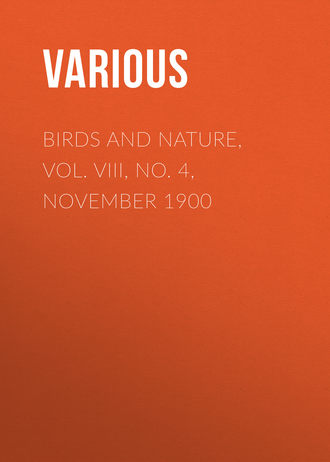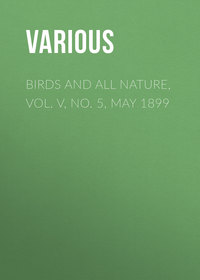 полная версия
полная версияПолная версия
Birds and Nature, Vol. VIII, No. 4, November 1900
For a number of years this graceful animal has been considered royal game for the sportsman and a good round-up of antelopes is considered a great achievement among hunters. Mr. G. O. Shields, in his interesting book, "Hunting in the Great West," very vividly describes a hunt for antelopes, and we cannot better illustrate the peculiarities of the animal than by giving his pen sketch:
"We had heard from some ranchmen along the way that the buffalo herd was at this time grazing about fifteen to twenty miles up the Big Porcupine, and knowing that antelopes are nearly always found hanging on the outskirts of every large herd of bison, we were on the look-out for them, for it would not seem at all strange to find them near the stage trail on which we were traveling. We scanned the country closely with the field glass and were finally rewarded by seeing a number of small white spots on the dead grass away up the Porcupine, that seemed to be moving. We rode toward them at a lively trot for perhaps a mile, and then stopped to reconnoitre again. From this point we could plainly distinguish them, though they looked to be about the size of jack rabbits. We again put the rowels to our donkeys and rode rapidly up to within about a mile of them, when we picketed our animals in a low swale, took out our antelope flag – a piece of scarlet calico about half a yard square – attached it to the end of my wiping stick, and were ready to interview the antelopes.
"I crawled to the top of a ridge within plain view of the game, and planted my flag. The breeze spread it out, kept it fluttering, and it soon attracted their attention. They were then near the bank of the river, grazing quietly, but this bit of colored rag excited their curiosity to a degree that rendered them restive, anxious, uneasy, and they seemed at once to be seized with an insatiable desire to find out what it was. An antelope has as much curiosity as a woman, and when they see any object that they don't quite understand, they will travel miles and run themselves into all kinds of danger to find out what it is. They have been known to follow an emigrant or freight wagon with a white cover several miles, and an Indian brings them within reach of his arrow by standing in plain view wrapped in his red blanket. Some hunters "flag" them by lying down on their back, holding one foot as high as possible, and swinging it to and fro. A piece of bright tin or a mirror answers the same purpose on a clear day. Almost any conspicuous or strange-looking object will attract them, but the most convenient, as well as the most reliable at all times, is the little red flag, such as we employed in this instance.
"Huffman went to the top of another ridge, to my right and some distance in advance, and Jack crawled into a hollow on the left, and well in advance, we three forming a half circle, into which it was our intention if possible to decoy the game. When they first discovered our flag they moved rapidly toward it, sometimes breaking into a trot, but when they had covered half the distance between us and their starting point, they began to grow suspicious and stopped. They circled around, turned back, walked a few steps, and then paused and looked back at the, to them, mysterious apparition. But they could not resist its magic influence. Again they turned and came toward it, stopped, and gazed curiously at it. The old buck who led the herd stamped impatiently, as if annoyed at being unable to solve the mystery. Then they walked cautiously toward us again, down an incline into a valley, which took them out of our sight, and out of sight of the flag. This of course rendered them still more impatient, and when they again came in sight on the next ridge, they were running. But as soon as their leader caught sight of the flag, he stopped, as did the others in their turn when they reached the top of the ridge. There were seven in the herd, two bucks, three does and two fawns. They were now not more than a hundred yards from me, and still less from the other two of our party. Their position was everything we could wish, and though we might possibly have brought them a few yards nearer, there was a possibility of their scenting us, even across the wind, which, of course, we had arranged to have in our favor, and I decided that rather than run the risk of this and the consequent stampede, I would shoot while I had a good chance. It had been arranged that I was to open the ball, so I drew my peep and globe sights down very finely, taking the white breast of the old buck for my bull's-eye, and pulled. Huffman's Kennedy and Jack's carbine paid their compliments to the pretty visitors at almost the same instant, and for about two or three minutes thereafter we fanned them about as vigorously as ever a herd got fanned under similar circumstances. The air was full of leaden missiles; the dry dust raised under and around the fleeing herd as it does when a team trots over a dusty road. Clouds of smoke hung over us, and the distant hills echoed the music of our artillery until the last white rump disappeared in the cottonwoods on the river bank.
"When the smoke of battle cleared away, and we looked over the field, we found that we had not burned our powder in vain. Five of the little fellows, the two bucks and three does, had fallen victims to their curiosity. The two fawns had, strangely enough, escaped, probably only because they, so much smaller than their parents, were less exposed."
The antelope have a curious way of protecting their young, when on the open prairie. This is accomplished by placing a ring of sharp-pointed cacti about a spot which has been beaten smooth by their hoofs. Inside this ample protection the animal cares for its young and secures ingress and egress for itself by jumping over the ring of cacti. This serves to protect them from the majority of their foes, which inhabit the open country.
The antelope does not thrive well in captivity, the older ones soon killing themselves in their attempts to escape. The young taken soon after their birth generally die early, unless very special care is bestowed upon them, and even if they survive the juvenile state, they are very likely to die when three or four months old, from pyaemic sores or inflammation of the limbs.
PLANT PROTECTION
In the of this journal it was shown how plants seek to avoid the visits of unsuitable insects to their flowers. This is one means of protection, but there are many others which are even more striking and vital. It is supposed by many that plants are helpless beings, which must submit to all sorts of unfavorable conditions which come upon them. This is far from true, for while plants as a rule are fixed and unable to escape from danger by flight, still they have very many ways of helping themselves.
Prominent among the dangers which come to active green plants are those which arise from too intense light, which may destroy the delicate working substances. Since the leaves are the great working organs in the manufacture of food, they are especially equipped for protection. Those leaves which must work in exposed places have many details of structure which are evidently for guarding them against the ill effects of too intense light. The most striking adaptations, however, are those which have to do with protective positions. Under ordinary circumstances leaves are placed so that their flat faces are exposed to the most intense light. In some cases this is so great a danger that the leaves are set edgewise, the edges being directed upwards and downwards. When a plant assumes this habit, the leaves are said to be in a profile position, and the plants are sometimes called "compass plants." The latter name has come from the fact that such leaves usually point north or south, and once it was assumed that this position was in response to some mysterious magnetic influence. It is found, however, that it is merely an effort on the part of the plant to protect its leaves from the intense light of midday, and at the same time to expose them to the morning and evening rays of much less intensity. If a leaf is to be placed with its edge upwards and its flat faces east and west, it follows of necessity that it will point either north or south.
Some leaves, however, have the power of shifting their position according to their needs, directing their flat surfaces toward the light, or more or less inclining them according to the danger. Perhaps the most completely adapted leaves of this kind are those of the "sensitive plants," whose leaves respond to various external influences by changing their positions. The sensitive plants abound in dry and hot regions, and one of the best known is represented in our illustration. It will be noticed that the leaves of this Mimosa are divided into very numerous small leaflets, which stretch in pairs along the leaf branches. When the time of intense light and dryness approaches some of the pairs of leaflets fold together, slightly reducing the surface exposure. As the unfavorable condition continues, more leaflets fold together, then still others, until finally all the leaflets may be folded together, and the leaves themselves may bend against the stem. It is like a sailing vessel gradually taking in sail as a storm approaches, until finally nothing is exposed, and the vessel weathers the storm by presenting only bare poles. These are but a few illustrations of the very numerous devices for escaping too intense light and the dangers which accompany it.
One common danger in temperate regions comes from the lowering of the temperature each night, which sometimes may chill the living substances to the danger point. This is particularly dangerous to seedlings, whose tender structures have not yet developed the ordinary protective coats. In the spring the seed leaves of numerous seedlings may be seen at the approach of night to rise upward and come together, just as the palms of the hand may be placed together over one's head. This reduces the surface of exposure and the danger of chill at least one-half. Darwin experimented upon these seedlings, and discovered that by preventing some of the seed leaves from moving, the seedlings were seriously injured. The leaves of very many plants assume a peculiar night position which tends to meet the danger of loss of heat. Often the three leaflets of the common clover, if growing in an exposed place, may be observed to fold together into a sort of tent-like arrangement.
Many plants are also observed to protect themselves against rain, as it is necessary for leaves to avoid becoming wet. If the water is allowed to soak in, the work of the leaves is at once interfered with. Hence it will be noticed that most leaves are able to shed water, partly by their position, partly by their structure. In many plants the leaves are so arranged that the water runs off toward the stem; in other plants the rain is shed outwards as from the eaves of a house. Some of the structures which prevent the rain from soaking in are a smooth epidermis, layers of cuticle, hairy coverings, etc. Interesting experiments may be performed with different leaves to test their power of shedding water. If a gentle spray be allowed to play upon different plants it will be observed that the water glances off at once from the surfaces of some leaves, runs off more slightly from others, and may be more or less retained by others.
Perhaps the most general preparation for protection in our region is that which is made for the coming of the winter's cold. In many cases plants do not attempt to protect their delicate structures from the severity of winter, but disappear entirely, leaving only well-protected seeds to carry them over into the next growing season. This results in the so-called "annual habit," which has been learned by many plants in order to escape a season of danger. Other plants do not disappear so completely, but everything above the surface of the ground dies, while the plant continues in the form of underground bulbs, tubers, or various thickened structures. This habit of seeking a subterranean retreat at the approach of some dangerous season is a very good one, and is found in many of our early spring plants. This subterranean habit has a great advantage over the annual habit, since a seed is very slow in bringing the plant back again, while a bulb can produce its plant very rapidly.
Still other plants preserve more of their structures than either the annuals or the ground-loving plants. For example, most of our trees have cultivated what is known as the deciduous habit, that is, they merely drop their leaves, which are the endangered structures, at the approach of the unfavorable season, and renew them again when the favorable conditions return. It should be remarked that these leaves do not fall because they are broken off, but that in a certain sense it is a process of growing off, which is carefully prepared for. One of the most prominent features associated with the deciduous habit is the autumnal coloration. The vivid colors which appear in the leaves of many trees just before the time of falling have attracted a great deal of attention, but although it is so prominent, the causes for it are very obscure. It will be noticed that this autumnal coloration consists in the development of various shades of two typical colors, yellow and red. It is known that the yellow is due to the breaking down of the green substances, so that it simply indicates a post mortem change, as may be noticed in connection with the blanching of celery in which the leaves and upper part of the stem may be green, the green may shade gradually into yellow, and finally into the pure white of complete blanching. The red coloring matter, however, is very different. Certain experiments upon plant colors have indicated that the presence of the red slightly increases the temperature by absorbing more heat. It is suggested that the red color may be a slight protection to the living substance which is ceasing to work, and which is in danger of exposure to cold. If this be true, it may be that the same explanation will cover the case of the red flush so conspicuous in buds and young leaves in early spring. It must not be supposed that the need of protection has developed the coloring, but since it is developed it may be of some such service to the plant. Even the conditions which determine autumnal coloration have not been made out certainly.
It is instructive to notice how differently the so-called evergreens, as pines, spruces, etc., have answered the problem of protection against the cold of winter. The evergreens, instead of dropping their leaves, have undertaken to protect them, giving them a small surface and very heavy walls. In this way protection has been secured at the expense of working power during the season of work. Reduced surface and thick walls are both obstacles to leaf work. On the other hand, the deciduous trees have developed the working power of their leaves to the greatest extent, giving them large surface exposure and comparatively delicate walls. It is out of the question to protect such an amount of surface during the winter, and hence the deciduous habit. The evergreens are saved the annual renewal of leaves, but lose in working power; the deciduous trees must renew their leaves annually, but gain greatly in working power.
To obtain the most striking instances of protection, however, one must examine plants which belong to permanently dry regions, such as may be found in the United States along the Mexican border, or in the regions of tropical deserts. In the first place, it will be noticed that the plants in general produce smaller leaves than in other regions. That this holds a direct relation to the dry conditions is evident from the fact that the same plant often produces smaller leaves in dry conditions than in moist. One of the most striking features of an arid country is the absence of large leaves. These reduced leaves are of various forms, such as the needle leaves of pines, or the thread-like leaves of certain sedges and grasses, or the narrow leaves with inrolled margins such as is common in many heath plants. The extreme of leaf reduction has been reached by the Cactus plants, whose leaves, so far as foliage is concerned, have disappeared entirely, and the leaf work is done by the surface of the globular, cylindrical, or flattened stems. A covering of hairs is an effective sun screen, and it is very common to find plants of dry regions characteristically hairy. In such regions it is to be observed also that dwarf growths prevail, so that the plant, as a whole, does not present such an exposure to the drouth as in regions of greater moisture. One of the most prominent measures of protection in dry regions is the organization of what are known as water reservoirs. Nearly all plants of such regions have leaves which are known as fleshy, that is, they are thick and juicy, being reservoirs of stored up moisture which is doled out cautiously according to the needs of the plant, without any wastefulness.
The whole subject of plant protection is an immense one, and the illustrations given above are merely intended to suggest that there is such a subject, and to lead to some observation of the various schemes of protection which are to be seen plainly on every hand.
John Merle Coulter.Nature is but a name for an effectWhose cause is God.– Cowper, "The Task."THE BIRTH OF A TREE
Once I lay 'neath quilt of green,All unthought of, all unseen;Little thinking of the worldOut of which I had been hurled.By and by, when quilt grew hot,Mother Nature touched my cot,Whispered softly in my ear,"Higher, higher, higher, dear."Painted lovely scenes for me,Saying, "Child, climb up and see."I was lazy, so I said,"Please, ma'am, let me stay in bed."Something whispered, "Child, I fearLife will be but meager here."Golden sunbeams bade me start,And a purpose filled my heart.I would leave my bed of ease,I would join the forest trees;Shelter travelers passing by,Hide squirrels in the branches high.Purpose, mighty power, led,Ever, ever on ahead,Till I grew up here so high,Near the sunlight and the sky.Mother Nature, mother dear,I am glad you called me here.Thus the mighty forest oakFrom his wooded homeland spoke.And I thought a lesson this —We, to reach the highest bliss,Must arise from beds of ease,Growing like the forest trees.Lucia Belle Cook.THE ALMOND
(Amygdalus communis L..)And it came to pass that on the morrow Moses went into the tabernacle of witness; and behold, the rod of Aaron for the house of Levi was budded, and brought forth buds, and blossomed blossoms, and yielded almonds. – Numbers 17:8.
The almond is the fruit of a small tree (Amygdalus communis) belonging to the Rose family (Rosaceae). The plant is believed to be a native of northern Africa, Persia and Turkestan. It occurs wild in Sicily and Greece and is cultivated throughout temperate Europe, including England.
The leaves of the almond tree are simple, broadly lanceolate, margins serrate, bright green and stalked. The flowers are nearly sessile, mostly solitary, petals bright pink; otherwise similar to the flowers of the rose family as seen in the apple blossom, cherry blossom and the wild rose. The fruit is a drupe or stone fruit, resembling the peach in its general structural characters. It is, however, much smaller, measuring about one and one-half inch in length. As in the peach the outer portion of the fruit coat (sarcocarp) is fleshy, the inner portion (endocarp or putamen) is hard and encloses the kernel or seed to which the term almond is usually applied. The plant is very ornamental, producing its beautiful flowers in March before the leaves are developed.
Two natural varieties of almonds are quite universally recognized, the sweet (A. communis var dulcis) and the bitter (A. communis var amara). They resemble each other so closely in general appearance that it is practically impossible to distinguish between them. The principal difference lies in the chemistry of the kernels or seeds themselves. In the bitter variety amygdalin is found, which is practically wanting in the sweet variety. Some botanists describe quite a number of varieties. Karsten, for instance, describes five varieties of A. communis, namely, dulcis, amara, fragilis, macrocarpa and persicoides. Boissier in his Flora Orientalis describes as many as seventeen distinct species.
The almond tree is one of the oldest of the cultivated plants. It was a great garden favorite in and about Palestine. It is frequently mentioned in the books of Moses. In Exodus 25:34, we find that the "candlestick shall have four bowls made like unto almonds." As explained in the 8th verse of chapter 17 of Numbers the blossoming rod of Aaron was from an almond tree. Even to this day Jews carry rods bearing almond blossoms to the synagogues on great festival days. The Romans designated the almonds (the kernels or seeds with the hard endocarp or shell) Nuces graecae (Greek nuts), from which it is concluded that the almond tree was brought to Italy from Greece. Almond oil was known to the ancient Greek and Roman writers. Plinius and Dioscorides make reference to the gum which exudes from the bark. Karl der Grosse (Charlemagne) recommended the cultivation of almonds in Germany. In view of the fact that some authorities state that the sweet variety is a product of cultivation, it is interesting to note that the two varieties have been known equally long. The bitter variety was described by Scribonius Largus and Plinius. Alexander Trallianus described the medicinal virtues of the oil of bitter almonds. Palladinus gave directions how to convert the bitter variety into the sweet variety by methods of cultivation. Later experiments have, however, proven this to be a false conclusion.
Description of Plate: – A, B, branch with flowers and fruit; 1, 1a, flowers from different trees; 2, 2a, petals; 3, stamens; 4, pollen; 5, stamen; 6, 7, ovary; 8, 9, seed with shell; 10, seed without shell; 11, 12, sections of seed.
The fruit and seeds of several other plants are known as almonds. The seeds of the African shrub Brabejum stellatifolium are known as African almonds. Country almonds is a name given to the fruit of the East Indian tree Terminalia Catappa. The fruit of Canarium commune is known as Java almonds.
At the present time the sweet almond is extensively cultivated in northern Africa, southern Europe and in the warmer parts of the United States, particularly in California. Climatic conditions and cultivation have a great influence upon the quality of the almonds and we have as a result quite a number of commercial varieties, just as we have commercial varieties of coffee, tea, oranges, etc. The more important commercial varieties are the Jordan, Valencia, Barbary and California almonds. These vary somewhat in size, form and thickness of the kernel and the hardness and thickness of the shell (endocarp). The Jordan almonds are imported from Malaga (Spain) and are said to be the finest. They differ from the others in the greater length of the kernel (seed), for which reason they are also known as long almonds. These are official in the English Pharmacopoeia because they are not readily confused with other sweet varieties and the bitter almond. The Valencia almonds come from the Balearic islands (Majorca); they are characterized by a comparatively soft shell and are less highly prized than the Jordan or the California almonds. The Barbary almonds from northern Africa are quite small and unsightly and for those reasons have comparatively little commercial value. In the United States the principal commercial variety is the California almond. The kernel is shorter and flatter than that of the Jordan almond, but almost equal to it in quality. It is extensively cultivated, about one hundred trees being planted to the acre. The trees attain a height of fifteen to twenty feet and begin to yield when three years old. In California it is customary to bleach the almonds by exposing them to the vapor of burning sulphur, which also destroys insect parasites which attack almonds very readily.
Other less important sweet commercial varieties are the Provence almonds of southern France, the Florence and Ambrosia almonds of Sicily, the Pitti almonds of Portugal and the small Puglia almonds of Italy.
The bitter almond seeds are as a rule somewhat shorter, broader and thinner than those of the larger, sweet varieties. Those found upon the market are largely from northern Africa, Sicily and southern France.
The principal constituents of sweet almonds are a fixed oil, sugar, some albuminoid substances, and perhaps a small quantity of amygdalin or a substance akin to it. The purified fixed oil from both varieties of almonds is a bland, thin, pale yellow liquid, having a faint taste and odor of the almond. When exposed to the air it becomes rancid quite readily. Medicinally it finds use as an emollient in external applications. Taken internally in small doses it is nutritious; in large doses laxative. Mixed with mucilage or yolk of eggs and sugar it is found useful in allaying troublesome coughs due to irritation of the throat. It also finds a table use similar to that of olive oil.











